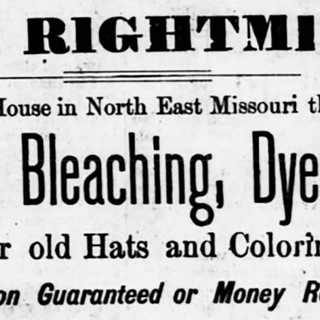J.B. Rightmire: Ever in search of the optimal opportunity

J.B. Rightmire was featured in an advertisement for Egg-O-See, a breakfast food produced by the Egg-O-See Cereal Company in Quincy, Ill., 1906. The caption read: “You wouldn’t wear a fur coat in summer? Yet when you eat greasy meats, and heavy, indigestible foods, you are heating the body as needlessly as if you were wrapped in bearskin. Change today to delicious, healthful, cooling Egg-O-See.” At the time, Rightmire and his son were operating a hat and fur store at 173 Wabash Ave., Chicago. (Photo by Jay Paull/Getty Images)
MARY LOU MONTGOMERY
John Baxter Rightmire wasn’t born or raised in Palmyra, Mo.; nevertheless, he considered the small Northeast Missouri town – Marion’s county seat – to be his hometown. To commemorate his adoration for the town nicknamed “Flower City,” while a resident of Chicago in 1908, he composed and published a song, “My Old Palmyra Home.”
Despite his one entry in the composing field, throughout his life his career was clearly defined: J.B. Rightmire was a salesman of considerable talent.
Born in West Virginia in 1848, Baxter Rightmire migrated to Memphis, Mo., in Scotland County, with his father – John A. Rightmire circa 1853.
The History of Marion County, Missouri, by R.I., Holcombe in 1884, outlines J.B. Rightmire’s earliest sales jobs.
At the age of 16, he was a salesman for Hudson and Paxton of Memphis, Mo., and continued in the employment of J.L. Mason at Memphis.
For the next five years, he worked for the H.E. Smith Co., in Palmyra.
Around 1875, he went west, and was employed as a clerk for the Phillips and Smallwood dry goods store in Doniphan, Kansas. Soon thereafter, he returned to Palmyra.
In 1878, he was married to Juliet Mitchell Anderson, daughter of Rufus E. Anderson, who was recently featured in this column.
The following year, their first child, Rufus Anderson Rightmire, was born.
In 1882, J.B. Rightmire worked as a commercial traveling salesman for the millinery department of Lockwood, Englehart and Co., in St. Joseph, Mo.
This led to his entry in the retail business, when he opened a millinery shop in the Thompson building on Main Street, Palmyra, in conjunction with his sister Maggie.
On March 30, 1883, Rightmire advertised in the Palmyra Spectator: “Ginghams! Ginghams! I have in stock 1,000 yards Domestic Ginghams, formerly 10 cents per yard, for 7 ½ cents, fast colors.”
Rightmire closed the business in 1885, and his millinery stock was purchased by his sister, Maggie Rightmire. She reopened her shop in the Krummel building.
Move to Quincy
J.B. Rightmire went to work for the prestigious store operated by Julius Kespohl, at the corner of Fourth and Maine Street, in Quincy, Ill. He moved his young family to the Gem City, residing at 1218 Hampshire. On May 6, 1887, he reached out to his Palmyra friends via an advertisement in the Palmyra Spectator:
“Ladies going to Quincy will be met at the train or ferry boat by notifying me before starting. J.B. Rightmire, with Julius Kespohl and Co.” (Two months later, the store moved to the corner of Sixth and Hampshire.)
His employment changed in rapid succession after that:
1887, Pollock and Murphy, Quincy.
1888, D.H. King and Co., wholesale millinery house of St. Louis.
And then, in May 1890, his wife unexpectedly died at the age of 29, leaving him with two young children – Rufus, age around 11, and his 3-year-old sister, Marguerite.
Chicago
In 1894, Rightmire was working for the Quincy Granite Marble Works. He once again asked his Palmyra friends for a share of their business.
By 1900, he had moved to Chicago, and was working as a dealer in furs. The family, consisting of his sisters, Maggie and Mary, and his son, Rufus A. Rightmire, lived at 891 Warren Ave.
In 1903, Rightmire and his son were operating a hat and fur store at 173 Wabash Ave.
Electric road
In 1903, J.B. Rightmire was living in Chicago, but his heart was still in Palmyra. He was planning an electric road, which would link Hannibal, Palmyra and Philadelphia, Mo. The Quincy Daily Journal, in explaining the feasibility of the Marion County Interurban, wrote in its Dec. 3, 1903 edition: “Rightmire is a man of energy and push. Mr. Rightmire says he has ample capital at his back and we personally know that several of the most prominent capitalists of St. Louis are interested in the enterprise.”
Alas, the road was not to be.
In January 1907, the Chicago Tribune published an account of Rightmire’s bankruptcy. “John B. Rightmire, salesman; liabilities $91,245, assets, $300.”
In 1912, Rightmire moved back to Palmyra, and started a new firm, The Sanitary Block Resurfacing Company. He served as president; R.S. McCall was vice president; and Rightmire’s son-in-law, Alonzo W. Mackey, was secretary-treasurer.
The Palmyra Spectator of Aug. 6, 1913 reported:
“A concern which is destined to revolutionize much of the old fashioned and unclean conditions under which butchers, leather manufacturers and harness makers work and one whose operations are now beginning to extend into every state of the Union and will eventually cover the entire civilized world, is the Sanitary Block Resurfacing Company whose main offices are located at Palmyra, Mo.”
The new machine was designed to cut a new surface on worn-out wood blocks, thus doubling their lifespan.
The machine allowed for the resurfacing of a block in 30 minutes.
Testimonials to the machine’s value were written by W.F. Morang, superintendent, Union Shoe Factory of the Hampton Brown Shoe Company, St. Louis; The Kroger Grocery and Bakery Co., St. Louis; The Calumet Market, Max Alexander, Chicago; Fred Krey, president of Krey Packing company, St. Louis; Fred Fischer, president, Fischer Meat Company, St. Louis; and M.A. Samuels, president, Samuels Grocery and Market Co., Chicago.
Rather than sell the machines outright, the business plan was to lease the machines and associated territories.
An advertisement in the Feb. 1 1914 edition of the St. Louis Post Dispatch illustrates the sales plan:
“Help wanted: Woman – a bright, aggressive, persistent woman to call on butchers; easy, pleasant work; good money. Sanitary Block Resurfacing Co., 1917 Olive St.”
Death summons
In late September 1914, J.B. Rightmire underwent an operation in Rochester, Minn., for bladder cancer. He returned to Palmyra, and lived with his daughter, Mrs. Alonzo Mackey, until his death in November 1914. He was buried at Greenwood Cemetery.
Centennial pageant
Five years after his death, an estimated 4,000 people attended the Pageant of Palmyra in July 1919. A special feature of the event, which was staged at the fairgrounds north of the city, was the performance of “My Old Palmyra Home,” by Miss Bertha Drescher. The Quincy Daily Herald of July 23, 1919, described the song, by the late J.B. Rightmire, “a simple song with quaint melody.”
To see the full advertisement featuring J.B. Rightmire, go to:
https://www.gettyimages.co.uk/detail/news-photo/advertisement-for-egg-o-see-by-the-egg-o-see-cereal-company-news-photo/159636458
Mary Lou Montgomery retired as editor of the Hannibal (Mo.) Courier-Post in 2014. She researches and writes narrative-style stories about the people who served as building blocks for this region’s foundation. Her collective works can be found at www.maryloumontgomery.com


































